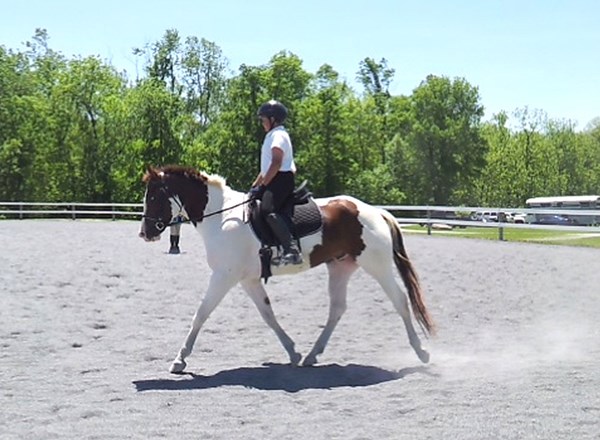
This photo was sent in by Devon Wallish’s mother, Joanne Shaw, who explained that she is on board as mother and as trainer. This is not an easy task. Being a mother myself, I know how difficult it can be to coach your own child.
Devon, 13, is showing his 4-year-old Paint, Bailey, in this photo. This is another challenge. Normally, you say, “experienced horses for young riders and experienced riders for young horses.” But no rule is without exception and Bailey and Devon appear to be a good match. For being at his first official show, the horse looks motivated, confident and relaxed. He shows a nice open trot stride and is balanced, showing self-carriage in a nice neck position.
In the photo Devon is posting the trot, and he appears to be concentrating and is focused on his job.
Analyzing his balance, I noticed that his lower leg is significantly longer than his upper leg. This is not something unusual in a boy growing, and even many adults have different-length upper and lower legs. Understanding this is important when working on balance and refining leg aids. A slight angle in the knee will cause a bigger movement of the foot. In the photo, Devon’s lower-leg position is slightly too far back. This can cause his balance to become more fragile. Devon shows a little tension in his shoulders, and secures his balance by keeping his hands low and close to the saddle. As a result, the line of his arm to the horse’s mouth is not straight from elbow to hand to rein; it is a broken line, and Devon’s hands appear to press down on the reins. Carrying his hands a little higher would sure help Devon to ride with a lighter contact and his hands would become more independent from his seat and balance.
Tip: This “juggling” exercise is a nice task to improve independent hands. While maintaining a consistent, light contact, the hands can be moved slightly up and down following the horse’s rhythm. The hands can move with every step of the horse (full rhythm) or every second step (half rhythm). To coordinate a different movement with the arms while performing rising trot (movement of the pelvis) is a good preparation for many tasks in riding.
This juggling exercise can help Devon not only carry his hands more freely and independently but become more supple in his shoulders also. The more experience he gains with rhythm and balance, the more he will be able to refine his aids and ride with light, invisible communicating aids on his horse, Bailey.
Susanne von Dietze is a leader in equestrian biomechanics. A physiotherapist, licensed Trainer A instructor and judge for dressage and show jumping, she gives lectures and seminars throughout the world, including at the prestigious German Riding Academy in Warendorf. She is a native of Germany and now lives with her husband and three children in Israel, where she competes at the international level. She is the author of two books on the biomechanics of riding: Balance in Movement and Horse and Rider, Back to Back. Find her books at HorseBooksEtc.com.











